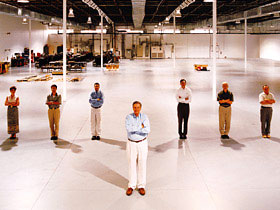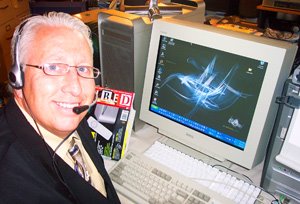Yes, They're Real!
Technically speaking, anyone can mine diamonds. But Robert Linares and his son Bryan can GROW them. In a process known as "chemical vapor deposition", the Linareses spray heated carbon gas over diamond chips. Under extreme pressure, the carbon atoms settle on the chips and conform to the structure. Wait a week or two, open the lid, and take out a fistful of diamonds of a size and quality almost impossible to find in nature.

A microwave plasma tool at the Naval Research Lab, used to create diamonds for high-temperature semiconductor experiments.Put pure carbon under enough heat and pressure - say, 2,200 degrees Fahrenheit and 50,000 atmospheres - and it will crystallize into the hardest material known. Those were the conditions that first forged diamonds deep in Earth's mantle 3.3 billion years ago. Replicating that environment in a lab isn't easy, but that hasn't kept dreamers from trying. Since the mid-19th century, dozens of these modern alchemists have been injured in accidents and explosions while attempting to manufacture diamonds.
 To grow single-crystal diamonds using chemical vapor deposition, you must first divine the exact combination of temperature, gas composition, and pressure - a "sweet spot" that results in the formation of a single crystal. Otherwise, innumerable small diamond crystals will rain down. Hitting on the single-crystal sweet spot is like locating a single grain of sand on the beach. There's only one combination among millions. In 1996, Linares found it.
To grow single-crystal diamonds using chemical vapor deposition, you must first divine the exact combination of temperature, gas composition, and pressure - a "sweet spot" that results in the formation of a single crystal. Otherwise, innumerable small diamond crystals will rain down. Hitting on the single-crystal sweet spot is like locating a single grain of sand on the beach. There's only one combination among millions. In 1996, Linares found it. Last June, he finally received a US patent for the process, which already is producing flawless stones. The price per carat: about $5.
Last June, he finally received a US patent for the process, which already is producing flawless stones. The price per carat: about $5.Note from Technophile: By the end of 2007, Apollo aims to be producing flawless 1-inch by 1-inch diamond cubes that could drive research in areas such as neurological implants (diamonds are bio-inert), high-density holographic storage (with many times the capacity of Blu-Ray or HD-DVD), and precise, efficient optical switches in Internet routers. Within 10 years, the company plans to be growing diamond wafers the size of DVDs for use as semiconductors!:: Source: [Apollo Diamond, Inc.]
:: Available: 2016
:: Innovation: Because diamond has a much higher melting point than silicon, Apollo's diamonds could be used to make much smaller, faster processors than are currently available (instead of a "Silicon Valley", we could have a "Diamond Valley").
 Note from Dan Lelevier, ET (Extreme Technology) Consumer Product Advisor: Jewelry Television offers fine jewelry, watches, loose gemstones, castings, jewelry-making tools and related books. Jewelry Television is one of the largest retailers of loose gemstones in the world and their online store is incredible. You will be very pleased with their wide selection of "gotta have" items, and you will LOVE their amazing prices! This site is a true "gem" of the Internet.
Note from Dan Lelevier, ET (Extreme Technology) Consumer Product Advisor: Jewelry Television offers fine jewelry, watches, loose gemstones, castings, jewelry-making tools and related books. Jewelry Television is one of the largest retailers of loose gemstones in the world and their online store is incredible. You will be very pleased with their wide selection of "gotta have" items, and you will LOVE their amazing prices! This site is a true "gem" of the Internet. :: FOLLOW UP from Technophile:
These diamonds are being called "immitation", "cultured", "synthetic", "real synthetic", and just plain "fake". Folks, these are real diamonds. These are not Cubic Zirconia or Moissanite, which are made to pass as diamonds. Lab-grown stones are the real thing. It's just that instead of the millions of years it takes to create natural diamonds, they're grown by man in a matter of days.
Even the Gemological Institute of America (GIA), the foremost diamond research and grading body, acknowledges that these are diamonds. "To say it's not diamond is really false," says William Boyajian, gemologist and GIA president. "It's just man-made diamond."
I also prefer to call them "man-made", or "manufactured" diamonds, as opposed to "natural" or "mined" diamonds. Of course, right now, I would only refer to the diamonds coming from either Apollo or Gemesis as being the real thing.
Gemesis uses High Pressure, High Temperature presses (HPHT) to create colored stones such as "fancy yellows". He uses Russian designed presses.
Apollo uses Chemical Vapor Deposition (CVD) to create colorless diamonds. The process came out of research at MIT into developing diamonds for computer chips.

What is not generally know is that Apollo diamonds are thin, and they are brown to grey. After production, they need expensive HPHT processing to remove the color.Beyond Gemesis and Apollo, one company is convinced theses diamonds are real: De Beers Diamond Trading Company. The London-based cartel has monopolized the diamond business for 115 years, forcing out rivals by ruthlessly controlling supply. But the sudden appearance of multicarat, gem-quality synthetics has sent De Beers scrambling.
Several years ago, it set up what it calls the Gem Defensive Programme - a none too subtle campaign to warn jewelers and the public about the arrival of "manufactured" diamonds. At no charge, the company is supplying gem labs with sophisticated machines designed to help distinguish "man-made" from "mined" stones.
 In its long history, De Beers has survived African insurrection, shrugged off American antitrust litigation, sidestepped criticism that it exploits third world workers, and contended with Australian, Siberian, and Canadian diamond discoveries. The firm has a huge advertising budget and a stranglehold on diamond distribution channels.
In its long history, De Beers has survived African insurrection, shrugged off American antitrust litigation, sidestepped criticism that it exploits third world workers, and contended with Australian, Siberian, and Canadian diamond discoveries. The firm has a huge advertising budget and a stranglehold on diamond distribution channels.But there's one thing De Beers doesn't have: retired brigadier General Carter Clarke. Clarke, 72, has been retired from the Army for nearly 30 years, but he never lost the air of command. When he walks into Gemesis - the company he founded in 1996 to make diamonds - the staff stands at attention to greet him.
His lieutenants have 27 diamond-making machines up and running -- with 250 planned -- at this factory outside Sarasota, Florida. Looks like De Beers is in for a war!
 You can order the above design printed on a black t-shirt (for a special friend, or yourself), by clicking here.
You can order the above design printed on a black t-shirt (for a special friend, or yourself), by clicking here.A similar design is also available on Baby Doll Tees, Spaghetti Tanks, Cap Sleeve Tees, Camisoles, Thongs, Women's Tanks, Raglans, and other Tees. And you can have it printed on Framed Art Prints, Hats, Teddy Bears, Aprons, Mugs, Pillows, and Mousepads.
It features a man-made diamond inside of a 3d heart shaped box (very cool)!




















25 Comments:
A photograph of the diamonds would be nice
I wonder when we'll see five-carat diamond rings for less than $100. Do you think the de Beers cartel might have something to say, *cough* extort *cough*, about that.
A midnight visit from the South African mafia would be no less than expected in this case.
Robert
I told my girlfriend that we would get married as soon as I could afford a 2-carat stone. May be sooner than I expect.
In attempts like these, usually the cost of production is higher than the value of the outcome product. It is still cheaper to mine diamonds.
As for micro processors, today the biggest bottle neck is the speed of light. To achieve faster speeds logical methods will be more in use than physical.
For your questions you can contact me from: metinkandiyoti@hotmail.com
Actually, DeBeers has already been planning for this for a few years, I belive I read somewhere that they have been supplying training and tools to distinguish man-made from from earth diamonds to jewelers for free. I for one am all for this technology to break their monopoly on this industry. --J
I've heard about this last year, but tought the process was too expensive to be worth it... If they ever start producing such diamonds for the consumer market, We'll probably see the value of diamonds crashing down.. at 5$ per carat, a box of chocolate would be more valuable.
Kiltak
[Geeks Are Sexy] Tech. News
gemesis also makes diamonds
A Diamond core hard drive, can't wait.
Are these guys a company, can I start ivesting in them now (stock alert)
Psichomofo@hotmail.com
After reading comments on digg.com, I followed a link to the Wired story from Sept. 2003. It is quite extensive and covers both the Gemesis high pressure high temperature solid solution method, and the Apollo Chemical vapor deposition method. Apparently the only news is that the Apollo patent issued in June 2005 (actually Feb 2005, see also the June 2003 patent), and that the size of the seed diamond wafers have increased from 10 mm, and are expected to yield 25 mm cubes by late 2007.
Wired magazine had an amazing article about apollo diamonds and their fight against de beers a couple of years ago. You can probably find the article at wired.com
As for micro processors, today the biggest bottle neck is the speed of light. To achieve faster speeds logical methods will be more in use than physical.
I'm sorry but this comment is increadibly inaccurate. The biggest thing holding back microprocessing right now is heat dissipation. They're making smaller and smaller chips with more and more transistors in them. It's reached the point that they just can't get the heat away from the chip fast enough. Thats the reason that for the last few years we havent seen much increase in the MHZ front, and instead Intel and AMD are rolling out the dual-core chips, insteading of making faster logic they're adding more parralelized logic. Now, since diamonds have a higher melting-point, their use in microprocessors might allow them to reach higher temperatures while still remaining stable.
PCworld interview with Steve Pawlowski, the director of Intel's Microprocessor Technology Lab:
http://www.pcworld.com/news/article/0,aid,115674,00.asp
IBM article on chip cooling:
http://www-128.ibm.com/developerworks/library/pa-chipschall5/
While very cool for scientific applications, i doubt any jewelers will be selling these as the picture seems to show.
Is it just me or is that diamond really ugly? It looks really milky in the picture. A quality diamond should be very transparent... If those are the diamonds they are making, they will be for research purposes only, nobody would wear that.
folks, the value of diamonds was totally contrived even before synthetics. diamonds are not rare, well not in the sense of what you are being charged.
real, synthetic, whatever...jewellers will continue to sell what debeers tells them to for the prices they state.
and morons getting married will continue to fund this scam.
my wife and i have discussed many times over the years how if we could do it again, we would just get her a massive cubic zirconia or whatever and just tell people it is real. seriously, if you keep you mouth shut, who the hell is going to know?
Re: Anonymous
Is it just me or is that diamond really ugly? It looks really milky in the picture. A quality diamond should be very transparent...
That is just a poorly done photograph. Currently the only way to tell if a well made artificial stone is artificial is through the property of phosphorescence. If you expose an artificial diamond to UV radiation it will glow for 3 to 5 seconds. Oh and an artificial diamond will not have a serial number laser engraved on it. Expect the artificial diamond manufacturers to overcome the phosphorescence issue soon.
Truth be told these artificial stones will reach quality and size combinations you or or I could never afford in a cartel controled diamond market. I don't know why people ascribe such mythical significance to the natural origin of diamonds. Carbon is carbon and if buying an artificial stone means you can afford a flawless 2 carat stone instead of a 1/2 carat stone with inclusions and an off color I don't think your wife to be will care. I for one welcome our new artificial diamond overlords...
In addition to the above mentioned Wired article there was a PBS Nova programme and here is the transcript:
http://www.pbs.org/wgbh/nova/transcripts/2703diamond.html
if they use diamonds in microprocessors because they have higher melting points and heat dissipation wouldn't have to be as good, the general idea is more heat right? Basically increasing the ammount of heat our computers put out and making it "okay" for the computer. Enviromentally speaking, couldn't that get a little uncomfortable? My 2 computers in my room already produce enough heat. During the winter it's knida nice, but the summer...the AC is always running. Anyways, just a silly observation. I think it's cool. As a guy, I'm looking forward to seeing dirt cheap diamond tipped drills and diamond toothed saws.
In response to stephen peer's response to my previous post...
Actually, more mhz is better, as long as you're talking about the same architecture. As you said, mhz for a p4 aren't comparable with mhz for a p3. This is because intel made a trade-off between frequency and average instructions per clock cycle. The p4 was made solely to hit high frequencies, without regard of the length of the pipeline necessary to do so.
But if you have two chips with the same architecture, lets say two p3's, then they have the same average instructions per clock cycle. Thus if one has a higher mhz than the other, then that one has better performence.
So, even with today's new directions in microprocessor design, higher mhz is still a goal to strive for. However, regardless of the architecture, the higher the mhz the more heat is generated.
Now as to why dual-core:
So, a you said, trends now are towards lower frequencies and better average instructions per cycle, as they should be. And one way to increase average instructions per cycle while retaining low fequencies is to just bolt on another core (this creates issues with banchmarking due to the need for multiple threads, but in todays multi-tasking environment I think these concerns are negligable)
silicon can be heated to 5000f app.
carbon to 5800 somthing. dimond howerver breaks down in high temperatures over time(near the melting point for silicon it would become normal carbon after a shorter lifespan than a cirix chip!)
I haven't seen it here yet, so I'll point out an important fact: In addition to having a very high melting point, diamond is pretty much the BEST conductor of heat known to man. If I recall it is nearly an order of magnitude better than copper. This trait is probably more important than the higher melting point.
Ah, wiki has something to say: (Thermal conductivity (298 K)
W·m-1·K-1)
Diamond 895 - 2300
Carbon Nanotubes 1400
Silver 429
Copper 386
http://en.wikipedia.org/wiki/Thermal_conductivity
Point being, that even at the SAME power consumption, a diamond based chip will *dissipate* the heat better, thus keeping the core running cooler (even though the system has to remove the same amount of heat), which will increase life span etc etc.
Cheers
Geoff
(quote): 'I don't know why people ascribe such mythical significance to the natural origin of diamonds.'
Because DeBeers were on the ball a few years ago when people first started playing with artificial diamonds, and have been waging a publicity war ever since.
They'll lose it in the end, when there's absolutely no difference between real and artificial but a serial number, but that could be decades away.
the thermoconductivity would only matter sofar as the pacaging would allow to escape(a heat sink still has its heat transfer limits and wene the difference in temp between the on die prossesor temp monitor is a degree different than the heatsink than what are you going to do). On the bright side a heat sink and the prossesor packaging being made out of dimond would do the trick.(the prossesor then might be the heat transfer bottle neck if it isnt made out of dimond).
This story was reported in Wired over a year ago. These diamonds are not artificial. They are 100% real, and the only difference between them and the one's mined from the earth is that these diamonds are perfect. Naturally occuring diamonds always have some imperfection, but these lab-made diamonds are perfect, which is how some jewelers are able to tell them apart. DeBeers had a fit when they first found out about them and went on a rampage getting equipment to many jewelers to enable them to identify these from their own diamonds.
You can already buy rings with lab-diamonds at www.staur.com . Can't wait until these get more exposure and put the entire ridiculous diamond industry out of business. Good riddance.
http://www.wired.com/wired/archive/11.09/diamond.html
I'll add a little something to this (kind of funny story). The stone in my wife's ring is a perfect 2k manmade diamond (yes, she knows). Now, I did end up spending $1600+ on the ring, but it wasn't for the rock.
Instead, for the money, I was any to design the ring myself (3d modeled in rhino), had a real scale 3D prototype made, and then had it handmade by this incredibly talented jewelry artist from an actual billet of platinum. I bought the stone loose from this hard to find diamond dealer (wonder why?), for I think it was around $150. I did buy 4 smaller real diamonds for it (your welcome DeBeers) only because the cost difference (between MM and mined) wasn't that much. My wife "LOVES" this ring. She’s a restaurant server and practically gets comments everyday from people (twice from jewelers) on how beautiful it is and what an incredible diamond is has. And, the thing is, she can actually wear it to work and not have to worry about having the stone fall out. Now I totally buy into the idea that a ring is a symbol of your love, but what ring do you think is a better symbol on my love to my wife. The one I had handmade with a lot of thought and effort, or some cheap ring with a $4000 "market value" mined diamond from any jeweler.
Now here’s the kicker though. I took her ring in, a while back, to a jewelry store (Jared’s I believe) to get it buffed and cleaned. The guy was all friendly at first (probably saw the 2k diamond at first and thought I had money), anyhow, he then pulls out this thing that looks like a soldering iron with a needle like metal tip. He touches it to the diamond and two seconds later he says "sorry, we cannot take your ring. We only deal with rings that have REAL diamond". But I just need to get it cleaned? "Sorry, thats our policy"
Ha ha, Jerks...
AB
The good part: diamonds won't be so 'priceless' after all, The bad part: diamonds aren't going to keep our girl friends happy after they hear about lab-diamonds. And iPod's aren't getting cheaper either. :)
The Geeks @ Geek 24: Gadgets, Technology and your daily dose of geek
Not only are they not $5 a carat, they aren't that big. Why are only .6 carat stones available?
Just curious since a friend was going to buy a ring for his girlfriend and I remembered this story from wired magazine. I'm not sure she would be satisfied with "only" .6 carats.
Keep up the great work though and I look forward to a day where kids trade two diamonds for a baseball card.
Post a Comment
<< Home